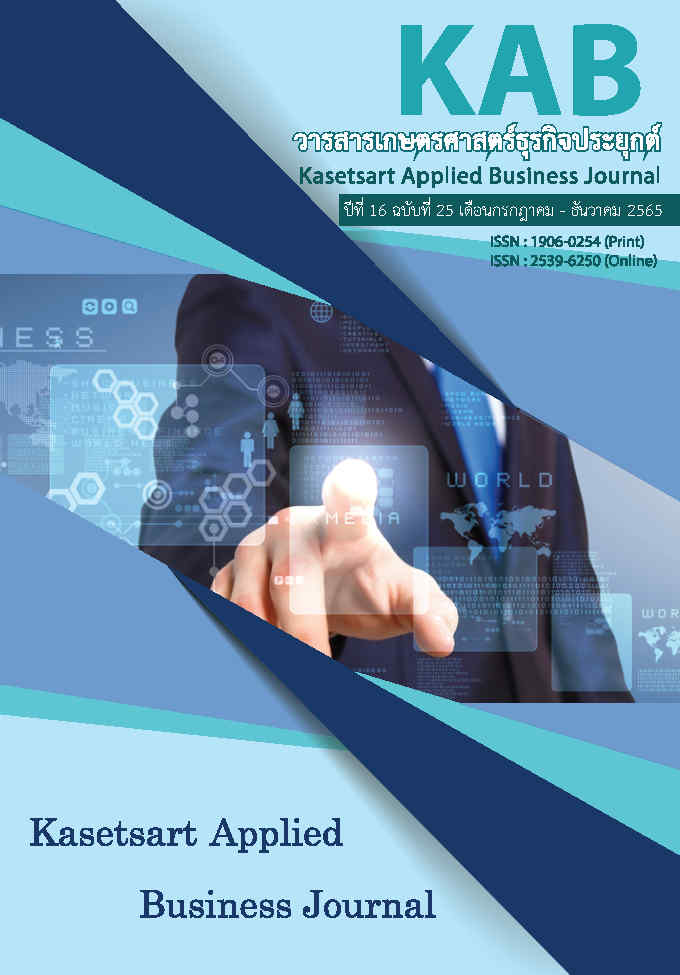อิทธิพลของภาวะผู้นำที่รับผิดชอบต่อสังคม การรับรู้ของผู้มีส่วนได้ส่วนเสียด้านความรับผิดชอบต่อสังคมขององค์การ ที่ส่งผลต่อภาพลักษณ์องค์การของท่าอากาศยานหาดใหญ่
Main Article Content
บทคัดย่อ
การศึกษาวิจัยครั้งนี้มีวัตถุประสงค์เพื่อ 1) เพื่อศึกษาความสัมพันธ์ระหว่างภาวะผู้นำที่รับผิดชอบต่อสังคมกับการรับรู้ของผู้มีส่วนได้ส่วนเสียด้านความรับผิดชอบต่อสังคมขององค์การของท่าอากาศยานหาดใหญ่ 2) เพื่อศึกษาอิทธิพลของภาวะผู้นำที่รับผิดชอบต่อสังคมต่อภาพลักษณ์องค์การของท่าอากาศยานหาดใหญ่ และ 3) เพื่อศึกษาอิทธิพลของภาวะผู้นำที่รับผิดชอบต่อสังคมต่อภาพลักษณ์องค์การของท่าอากาศยานหาดใหญ่ ทั้งทางตรงและทางอ้อมผ่านการรับรู้ของผู้มีส่วนได้ส่วนเสียด้านความรับผิดชอบต่อสังคมขององค์การ กลุ่มตัวอย่างเป็นผู้มีส่วนได้ส่วนเสียของท่าอากาศยานหาดใหญ่ ใช้การสุ่มตัวอย่างแบบโควต้าและดุลพินิจ จำนวนตัวอย่างที่ใช้ได้จำนวน 397 ชุด
ผลการวิจัยมีค่าสัมประสิทธิ์สหสัมพันธ์ระหว่างตัวแปรสังเกตได้ระหว่าง 0.585-0.959 และมีนัยสำคัญทุกตัวแปร จากการวิเคราะห์ตัวแบบสมการโครงสร้างพบว่าภาวะผู้นำที่รับผิดชอบต่อสังคมมีอิทธิพลต่อการรับรู้ของผู้มีส่วนได้ส่วนเสียด้านความรับผิดชอบต่อสังคมขององค์การอย่างมีนัยสำคัญและมีค่าความแปรปรวนที่ถูกทำนายโดยภาวะผู้นำที่รับผิดชอบต่อสังคมร้อยละ 52.3 นอกจากนั้นภาวะผู้นำที่รับผิดชอบต่อสังคมมีอิทธิพลทางตรงต่อภาพลักษณ์องค์การอย่างมีนัยสำคัญ และมีอิทธิพลทางอ้อมผ่านการรับรู้ของผู้มีส่วนได้ส่วนเสียด้านความรับผิดชอบต่อสังคมขององค์การอย่างมีนัยสำคัญและมีค่าความแปรปรวนที่ทำนายภาพลักษณ์องค์การร้อยละ87.67 สุดท้าย การรับรู้ของผู้มีส่วนได้ส่วนเสียด้านความรับผิดชอบต่อสังคมขององค์การมีอิทธิพลทางตรงต่อภาพลักษณ์องค์การ อย่างมีนัยสำคัญ และมีค่าดัชนีความเหมาะสม c2/df = 4.71; CFI = 0.991; NNFI = 0.985; RMSEA = 0.097 และ 90% CI for RMSEA = 0.080
Article Details

อนุญาตภายใต้เงื่อนไข Creative Commons Attribution-NonCommercial-NoDerivatives 4.0 International License.
Journal of TCI is licensed under a Creative Commons Attribution-NonCommercial-NoDerivatives 4.0 International (CC BY-NC-ND 4.0) licence, unless otherwise stated. Please read our Policies page for more information...
เอกสารอ้างอิง
คณะทำงานส่งเสริมความรับผิดชอบต่อสังคมและสิ่งแวดล้อมของบริษัทจดทะเบียน. (2551). เข็มทิศธุรกิจเพื่อสังคม. สถาบันธุรกิจเพื่อสังคม.
ธนภัทร สุวรรณมณี และพิพัฒน์ นนทนาธรณ์. (2563). อิทธิพลของภาวะผู้นำการปฏิรูปและความรับผิดชอบต่อสังคมที่ส่งผลต่อภาพลักษณ์องค์การ: กรณีศึกษาพนักงานบริษัท อินเตอร์คลีนนิ่งซัพพลายส์ จำกัด. วารสารสมาคมนักวิจัย. 25(2), 162-175.
บุญเสริม สาตราภัย. (2546). เชียงใหม่กับภัยทางอากาศ. สายธาร.
พิพัฒน์ นนทนาธรณ์. (2558ก). ปัจจัยเชิงสาเหตุของภาวะผู้นำที่รับผิดชอบต่อสังคมที่มีอิทธิพลต่อภาพลักษณ์องค์การของท่าอากาศยานสุวรรณภูมิ. วารสารสมาคมนักวิจัย. 20(2), 48-58.
พิพัฒน์ นนทนาธรณ์. (2558). ภาวะผู้นำเชิงปฏิบัติการ: Life model. (พิมพ์ครั้งที่ 2). มหาวิทยาลัยเกษตรศาสตร์ คณะบริหารธุรกิจ ศูนย์ผู้นำธุรกิจเพื่อสังคม.
พิพัฒน์ นนทนาธรณ์. (2559ก). การจัดการความรับผิดชอบต่อสังคมขององค์การ. (พิมพ์ครั้งที่ 2). มหาวิทยาลัยเกษตรศาสตร์ คณะบริหารธุรกิจ ศูนย์ผู้นำธุรกิจเพื่อสังคม.
พิพัฒน์ นนทนาธรณ์. (2559). อิทธิพลของภาวะผู้นำที่รับผิดชอบต่อสังคม การรับรู้ของผู้มีส่วนได้ส่วนเสียด้านความรับผิดชอบต่อสังคมขององค์การที่ส่งผลต่อต่อภาพลักษณ์องค์การของท่าอากาศยานเชียงใหม่. วารสารสมาคมนักวิจัย. 21(2), 202-212.
พิพัฒน์ นนทนาธรณ์. (2561). อิทธิพลของภาวะผู้นำที่รับผิดชอบต่อสังคม การรับรู้ของผู้มีส่วนได้ส่วนเสียด้านความรับผิดชอบต่อสังคมขององค์การที่ส่งผลต่อภาพลักษณ์องค์การของท่าอากาศยานแม่ฟ้าหลวง เชียงราย. วารสารเกษตรศาสตร์ธุรกิจประยุกต์. 12(17), 73-88.
Carroll, A. B. (Ed.). (1977). Managing corporate social responsibility. Little, Brown.
Carroll, A. B., & Buchholtz, A. K. (2006). Business and Society (6th ed.). USA: Thomson South-Western.
Cheney, G., & Vibbert, S. L. (1987). Corporate discourse. Handbook of Organizational Communication: An Interdisciplinary Perspective, Newbury Park CA: Sage.
Czerniachowicz, B., Lis, A., & Wieczorek-Szymańska, A. (2017). The relationships between leadership and corporate social responsibility: Systematic literature review. Journal of Corporate Responsibility and Leadership, 4(3), 9-23.
Diamantopoulos, A., Siguaw, J. A., & Siguaw, J. A. (2000). Introducing LISREL: A guide for the uninitiated. Sage.
Dutton, J. E., & Dukerich, J. M. (1991). Keeping an eye on the mirror: Image and identity in organizational adaptation. Academy of management journal, 34(3), 517-554.
Dutton, J. E., Dukerich, J. M., & Harquail, C. V. (1994). Organizational images and member identification. Administrative Science Quarterly, 39, 239-263.
Elqassaby, H. K. (2019). The relationship between ethical leadership and corporate social responsibility. International Journal of Economics, Commerce and Management, VII(12), 492-521.
Hooper, D., Coughlan, J., & Mullen, M. R. (2008). Model Fit. Electronic Journal of Business Research Methods, 6(1), 53-60.
Kotler, P., & Lee, N. (2005). Corporate Social Responsibility. John Wiley & Sons.(2009). Up and Out of Poverty: The Social Marketing Solution. Upper Saddle River: Wharton School.
Lee, S. S., Kim, Y., & Roh, T. (2019). Modified pyramid of CSR for corporate image and customer loyalty: Focusing on the moderating role of the CSR experience. Sustainability, 11(17), 4745.
Leech, N. L., Barrett, K. C., & Morgan, G. A. (2005). SPSS for Intermediate Statistics: Use and Interpretation (2nd ed.). Mahwah, NJ: Lawrence Erlbaum Associates.
Moffitt, M. A. (1994). Collapsing and Integrating Concepts of" Public" and" Image" into a New Theory. Public Relations Review, 20(2), 159-70.
Pless, N. M. (2007). Understanding responsible leadership: Role identity and motivational drivers. Journal of Business Ethics, 74(4), 437-456.
Porter, M. E., & Kramer, M. R. (2006).“Strategy & Society: The Link between Competitive Advantage and Corporate Social Responsibility. Harvard Business Review. HBR.ORG. December (2011). “Creating Shared Value: How to reinvent capitalism- and unleash a wave of innovation and growth.” Harvard Business Review. HBR.ORG. January-February.
Waldman, D. A. (2007). Best Practices in Leading at Strategic Levels: A Social Responsibility Perspective in Jay A. Conger and Ronald E. Riggio, (Eds), The Practice of Leadership, Jossey-Bass.
Vazifehdust, H., Mojoudi, A., & Jalalian, S. (2014). The effect of corporate social responsibility on corporate image, customer satisfaction and loyalty in the banking industry (Case Study: Tehran Melli Bank). In Conference of Development and innovation management in management empowerment (pp. 1-23).
Yasin, R. (2021). Responsible leadership and employees’ turnover intention. Journal of Knowledge Management. January, 1-22.


